ISSN ONLINE(2278-8875) PRINT (2320-3765)
ISSN ONLINE(2278-8875) PRINT (2320-3765)
Savita M Shaka.1 Prashant R.T. 1 Vani R.M.2 and Hunagund P.V.1
|
| Related article at Pubmed, Scholar Google |
Visit for more related articles at International Journal of Advanced Research in Electrical, Electronics and Instrumentation Engineering
In this paper the study is done by loading the various types of Electromagnetic Band Gap (EBG) cells on the ground plane of the Microstrip antenna (MSA). The antenna1 gives a virtual size reduction of 59.10% and gives a multi bands and operates in the frequency range of 1 to 15 GHz and gives the enhanced bandwidth of 33.35%. The antenna2 gives a maximum virtual size reduction of 80.3% and gives a multi bands and operates in the frequency range of 2 to 14 GHz and gives the enhanced bandwidth of 61.85%. The proposed antenna is simple in its structure with low cost substrate material. The proposed antenna may find application in microwave communication systems
Keywords |
| Microstrip Antenna, Electromagnetic Band Gap (EBG), STAR EBG, Uniplanar EBG, Back lobes. |
INTRODUCTION |
| Modern communication devices and applications such as mobile cellular handsets, cordless phones, blue tooth devices and WLAN’s call for an extreme compact antenna covering a wide operational bandwidth. Microstrip antennas are attractive as they have several advantages like low cost, low profile planar configuration. But the antenna size is large for operation in the frequency bands of mentioned applications [1]. Moreover the bandwidth of microstrip antenna is relatively narrow. Several promising techniques are reported in the literature for enhancing the bandwidth, of microstrip antennas. But these methods are effective with a compromise over area and thickness of the antenna [2]. The main disadvantages are excitation of surface waves that occurs in the substrate layer & radiation of electromagnetic energy in different directions from radiations source. Surface waves are undesired because when a patch antenna radiates, a portion of total available radiated power becomes trapped along the surface of the substrate. Therefore, surface wave can reduce the antenna efficiency, gain and bandwidth [3-4]. |
| One solution to reduce above drawbacks is using EBG structure. The EBG structures are periodic structures that are composed of dielectric, metal or metallo-dielectric materials. These structures can prevent or assist wave propagation in special directions and frequencies therefore they can be used as spatial and frequency filter [5]. The uniplanar EBG cells are easy to fabricate by print and etch method. The EBG surfaces have advantages, of low profile, light weight, and low fabrication cost, and are widely considered in antenna engineering [6]. Thus, it specifies the fabrication process & is compatible with microwave & millimetre wave circuit. |
| In this paper a simple technique has been demonstrated to construct the microstrip antenna for virtual size reduction and multiband operation. The antenna gives highest virtual size reduction and enhanced bandwidth by loading EBG cells on the ground plane. The proposed antenna gives backlobe reduction radiation characteristics. The obtained results are quite good compared to the literature values. |
II. ANTENNA & EBG STRUCTURE |
| In this paper a conventional microstrip antenna (MSA) has been designed for 6GHz.The antenna is designed on FR4 with dielectric constant εr = 4.4 and with the height of h=1.6mm with the width of W=15.24mm and the length L=11.33mm respectively. The antenna is fed by strip line fed Lf50=6.18mm & Wf50=3.06mm to match the impedance and quarter wave transformer Lt=4.92mm & Wt=0.5mm is used and ground plane Lg=40mm & Wg=40mm is considered for the design. The geometry is as shown in Fig.1 (a) and the photographic view of the conventional MSA antenna is shown in the Fig.1 (b). In this a study of MSA is done by loading different types of EBG, i.e., Uniplanar EBG (UC-EBG) and STAR-EBG. In antenna1 enhancement of bandwidth is done by using UC-EBG and in antenna2 the enhancement of bandwidth is done by using STAR-EBG. |
| Initially the study is carried out by loading the conducting ground plane of the MSA with high impedance surface UCEBG cells for bandwidth enhancement by keeping all the parameter of the radiating patch and feeding technique constant. The geometry of the MSAUC-EBG antenna and the single enlarged unit of the UC-EBG cell are shown in the Fig. 2(a). There are 4x4 UC-EBG cells with dimension of 9mmx9mm, the parameters s=3mm and t=2mm and g=4mm are shown in Fig. 2(b). |
| Further the study is carried out by loading the conducting ground plane of the MSA with high impedance surface STAR-EBG cells for bandwidth enhancement by keeping all the parameter of the radiating patch and feeding technique constant. The geometry of the MSASTAR-EBG antenna and the single enlarged unit of the STAR-EBG cell is as shown in the Fig.3 (a). There are 3x3 UC-EBG cells with dimension of 8mmx8mm and a gap between each STAREBG cells g=8mm, there are four arms in the STAR-EBG cells each of width x=8mm and the length y=1.5mm are shown in Fig. 3(b). |
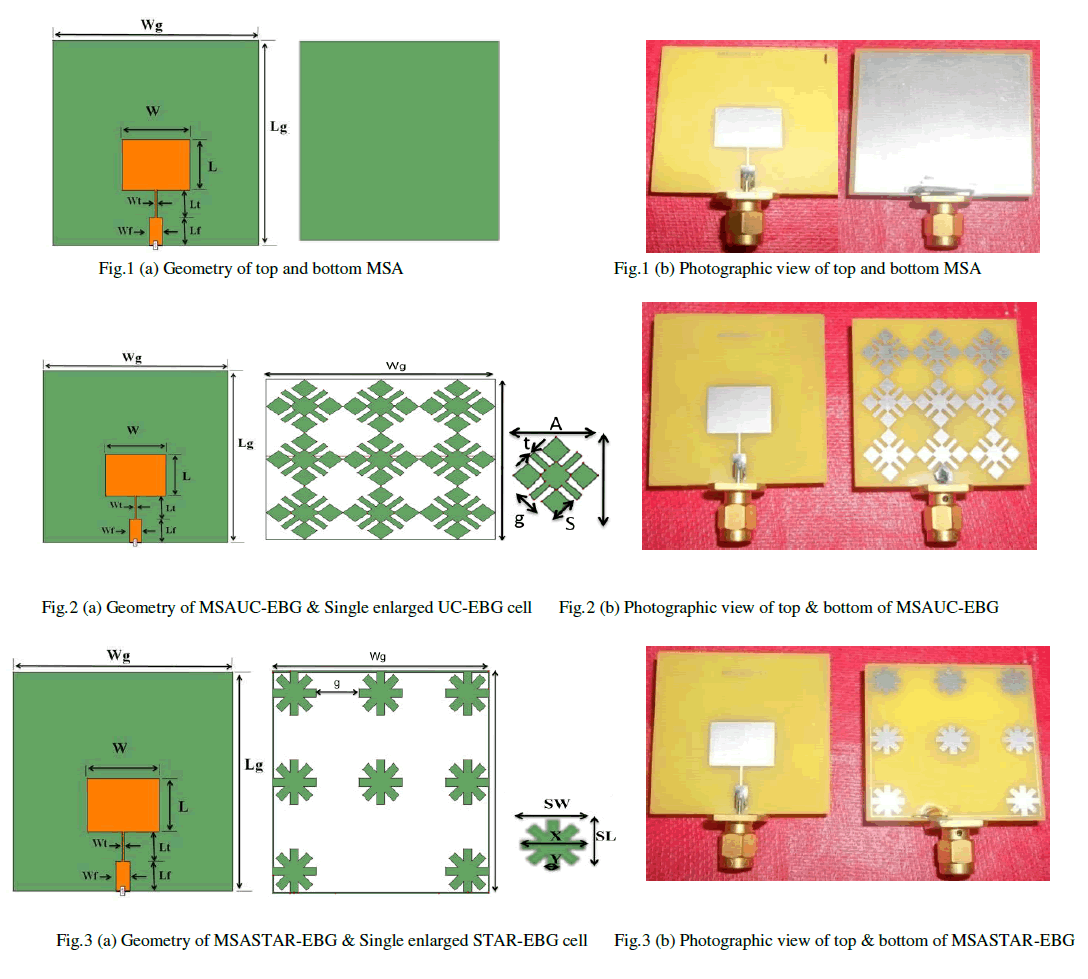 |
III. EXPERIMENTAL RESULTS |
| The characteristics of proposed antennas have been experimentally measured with Vector Network Analyzer (Rohde & Schwarz, Germany make ZVK model 1127.28651).The variation of return loss versus frequency characteristics of proposed antennas, MSA, MSAUC-EBG & MSASTAR-EBG are as shown in Fig.4 (a), 4(b) and 4(c). The antenna with EBG i.e., MSAUC-EBG & MSASTAR-EBG are giving multifrequency with increase in bandwidth. From the figure 4(a), it is found that, the antenna MSA resonates at f=5.99GHz. From this figure 4(b), it is found that, the antenna MSAUC-EBG operates between 2 to 13 GHz and gives a four bands with f1=2.59GHz, f2=7.84GHz, f3=10.26GHz, f4=12.59GHz. Similarly MSASTAR-EBG operates between 1GHz to 15GHz and gives five bands with f1=1.18GHz, f2=1.79GHz, f3=5.48GHz, f4=10.22GHz, f5=12.25GHz. So the overall bandwidth measured for MSAUC-EBG is 33.35% & gives a size reduction of 59.10% and gives increased gain of 21.3dB,for MSASTAR-EBG is the overall bandwidth is 61.85% and gives the size reduction 81.3% and gives increased gain of 11.43dB. From the results it is clear that by using the EBG on the ground plane there is an increase in bandwidth and size reduction. All the results are reported in table1. |
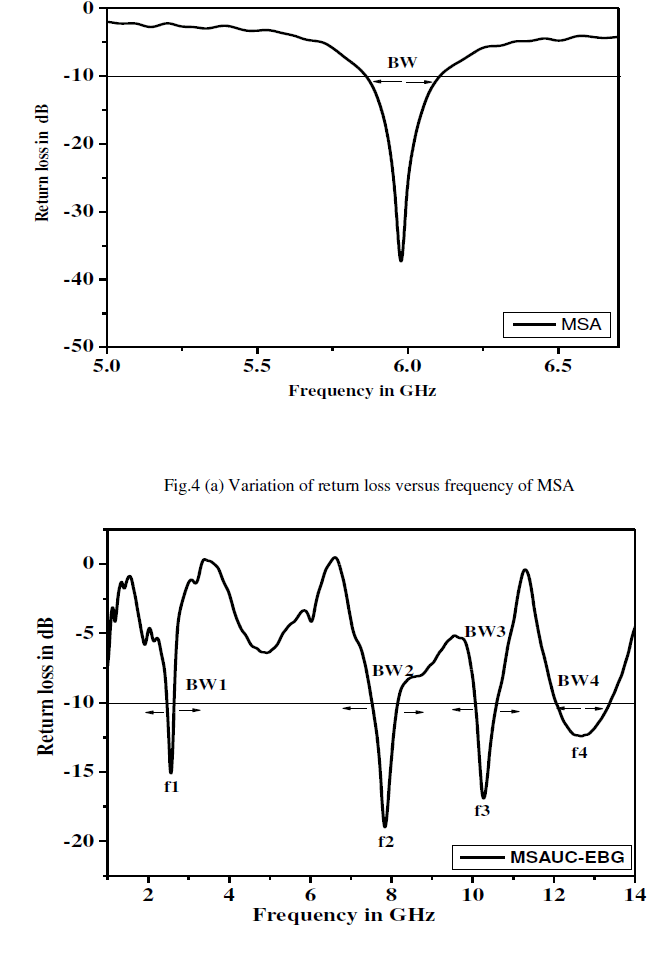 |
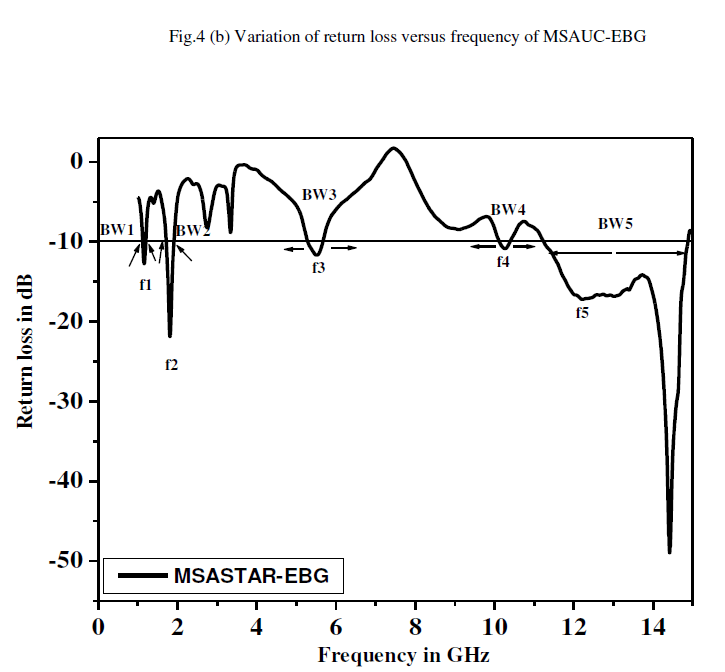 |
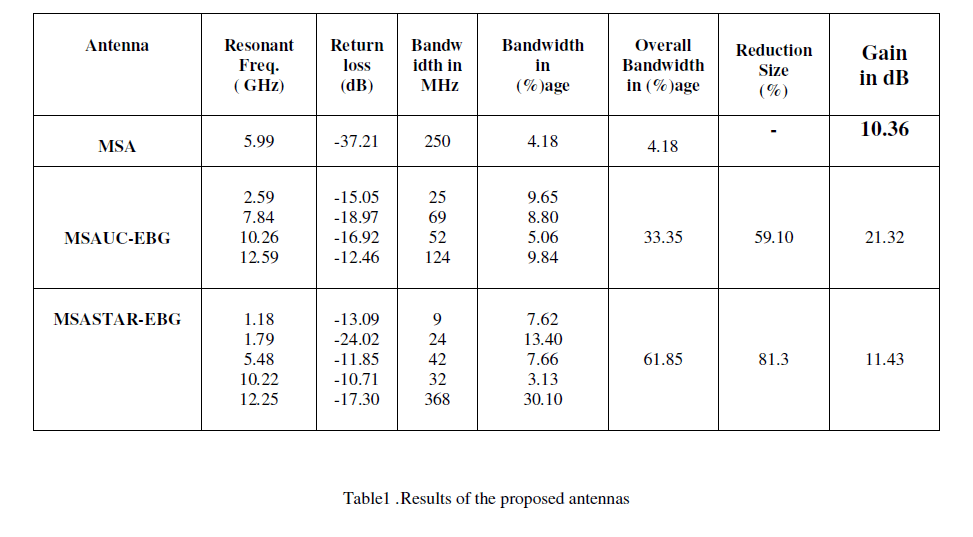 |
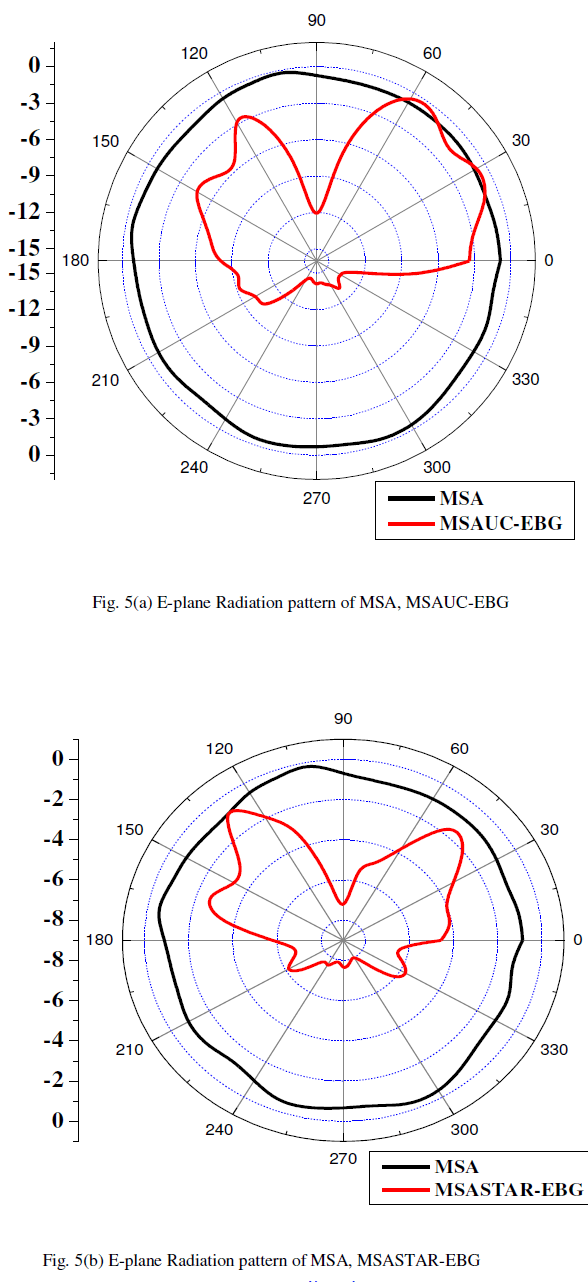 |
IV. CONCLUSION |
| From the detailed experimental study, it is concluded that, the by loading EBG cells on the ground plane of the RMSA the antenna gives a increased gain of 21.32dB and bandwidth is enhanced by 33.35% with MSAUC-EBG and virtual size reduction of 21.32%. The RMSA with star EBG gives a enhanced bandwidth 61.85% and gives a highest virtual size reduction of 81.3 % and a increase in gain of 11.43dB. The proposed antenna is simple in its structure and uses low cost substrate material. The antenna operates between 1 to 15GHz and gives back lobe reduction in radiation pattern when compared to the RMSA. The proposed antenna may find application in microwave communication systems. |
ACKNOWLEDGMENT |
| The authors would like to convey thanks to the department of science & technology (DST) government of India, New Delhi, for sanctioning vector Network analyzer to this department under FIST project. |
References |
|